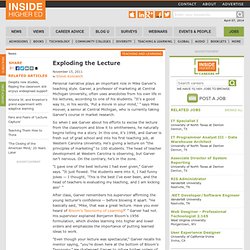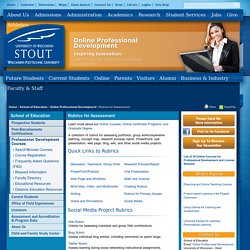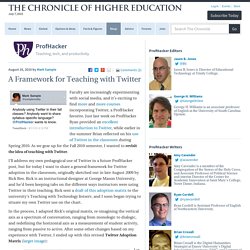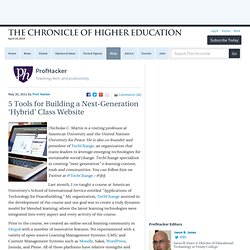

Professor tries improving lectures by removing them from class. Personal narrative plays an important role in Mike Garver’s teaching style.

Garver, a professor of marketing at Central Michigan University, often uses anecdotes from his own life in his lectures, according to one of his students. “It’s a good way to, in his words, ‘Put a movie in your mind,’ ” says Mike Hoover, a senior at Central Michigan, who is currently taking Garver’s course in market research. So when I ask Garver about his efforts to excise the lecture from the classroom and blow it to smithereens, he naturally begins telling me a story. In this one, it’s 1998, and Garver is fresh out of grad school and into his first teaching job, at Western Carolina University.
He’s giving a lecture on “the principles of marketing” to 100 students. “I gave one of the best lectures I had ever given,” Garver says. After class, Garver remembers his supervisor affirming the young lecturer’s confidence -- before blowing it apart. I tell Garver it’s obvious that he is in marketing. Create. Share. Learn. Where everyone can create, publish, share and take tests, exercises and assignments. Rubrics for Assessment Online Professional Development - UW Stout, Wisconsin's Polytechnic University. Learn more about our Online Courses, Online Certificate Programs, and Graduate Degree A collection of rubrics for assessing portfolios, group work/cooperative learning, concept map, research process/ report, PowerPoint, oral presentation, web page, blog, wiki, and other social media projects.

Quick Links to Rubrics Social Media Project Rubrics Wiki RubricCriteria for assessing individual and group Wiki contributions. Blog RubricAssess individual blog entries, including comments on peers' blogs. Twitter RubricAssess learning during social networking instructional assignments. Discussion, Teamwork, and Group Work Rubrics Online Discussion Board RubricAssessing ability to share perspectives, refine thoughts through the writing process, and participate in meaningful discussionPrimary Grade Self-Evaluation Teamwork Rubric (PDF)Features of a sandwich to graphically show the criteria PowerPoint and Podcast Rubrics A+ PowerPoint Rubric Joan Vandervelde's rubric provides 10 performance categories.
The Social Compass is the GPS for the Adaptive Business Brian Solis. InShare286 Over the years, I’ve written extensively about the need to extend opportunities in social media beyond marketing and customer service to set the stage for the social business.

I believe that the impact lies beyond the socialization of business; it introduces us to a genre of an adaptive business, an entity that can earn relevance now and over time by listening, engaging, and learning. In October 2009, I worked with JESS3 to visualize corporate transparency and authenticity for the release of Engage. In the process, I realized that those two words, transparent and authentic, didn’t carry tangible business value to leaders and decision makers. Please, before you think about engaging in social media, I need you to do two things…be transparent and authentic in all you do. Got it? While the words carry great importance, in all honesty, it’s our job to define the role of transparency and authenticity in business.
Exploring The Social Compass Center: The Brand Halo 1: The Players - Poster. A Framework for Teaching with Twitter. Faculty are increasingly experimenting with social media, and it’s exciting to find more and more courses incorporating Twitter, a ProfHacker favorite.

Just last week on ProfHacker Ryan provided an excellent introduction to Twitter, while earlier in the summer Brian reflected on his use of Twitter in the classroom during Spring 2010. As we gear up for the Fall 2010 semester, I wanted to revisit the idea of teaching with Twitter. I’ll address my own pedagogical use of Twitter in a future ProfHacker post, but for today I want to share a general framework for Twitter adoption in the classroom, originally sketched out in late August 2009 by Rick Reo.
Rick is an instructional designer at George Mason University, and he’d been keeping tabs on the different ways instructors were using Twitter in their teaching. Rick sent a draft of this adoption matrix to the university’s Teaching with Technology listserv, and I soon began trying to situate my own Twitter use on the chart. How about you? 5 Tools for Building a Next-Generation 'Hybrid' Class Website.
[Nicholas C.

Martin is a visiting professor at American University and the United Nations University for Peace. He is also co-founder and president of TechChange, an organization that trains leaders to leverage emerging technologies for sustainable social change. TechChange specializes in creating “next-generation” e-learning content, tools and communities. You can follow him on Twitter at @TechChange. --@jbj] Last month, I co-taught a course at American University’s School of International Service entitled ”Applications of Technology for Peacebuilding.” Prior to the course, we created an online social learning community in Drupal with a number of innovative features. Once we got the Drupal site up and running we began creating and embedding various tools to support the learning process.
If you’re interested in seeing some of these tools in action you can view a sample TechChange Unit. What We’re Working on Next: Photo provided by Nick Martin. TechChange.